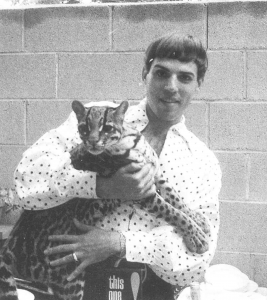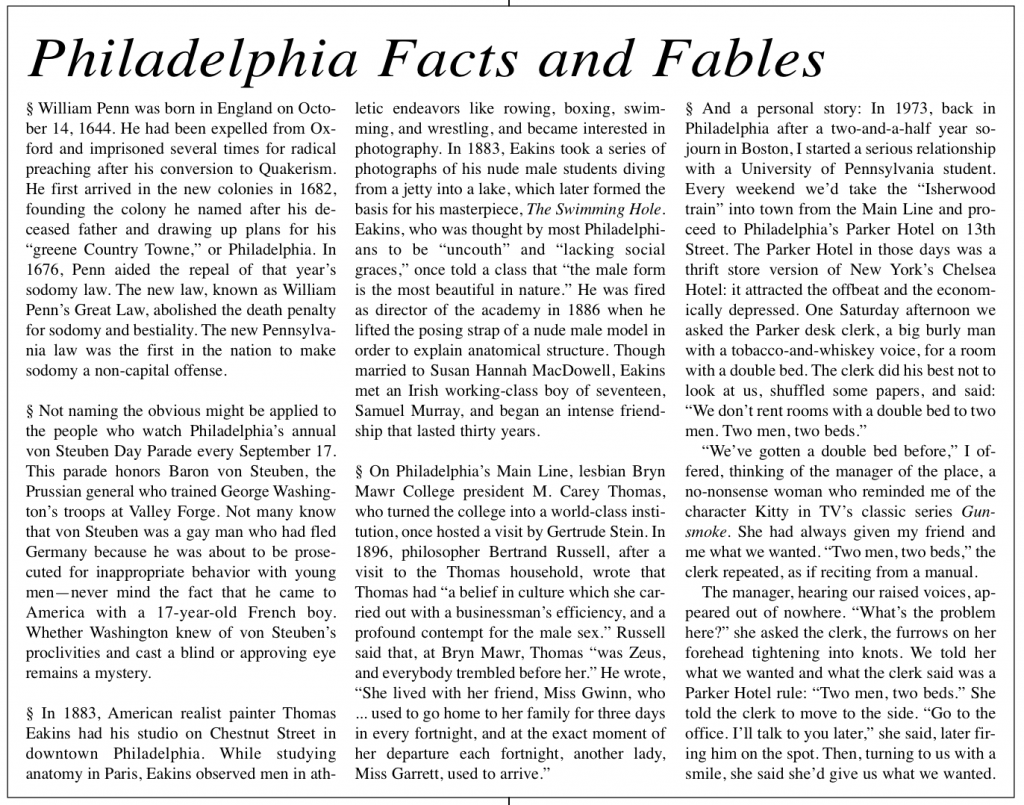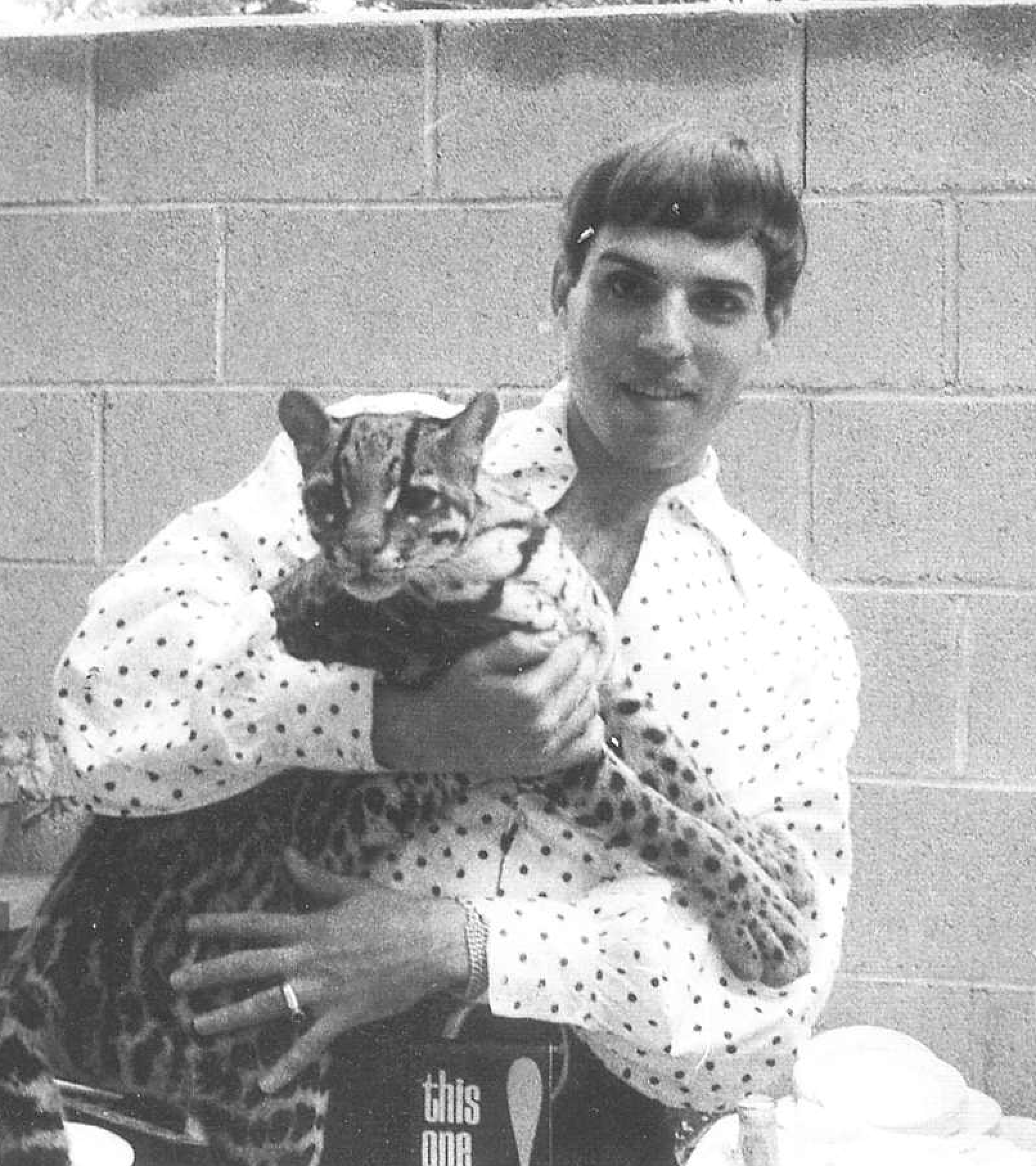IN HIS DIARIES Christopher Isherwood wrote about going to Philadelphia’s Camac Street Baths when he worked on Philadelphia’s Main Line as a conscientious objector. The time was WW II and Isherwood, riding the train from Haverford into the city, noted that “The men were tall, bony, big shouldered, fair haired and quite nice looking, but somehow fatally ‘pithed,’ as though the marrow had been drained from their bones.” The women, Isherwood wrote, “were bright and energetic. They used no makeup, and their white skin was dotted with freckles. They had sandy gold hair, dragged back and twisted into a knot. The country we were passing couldn’t possibly have been less ‘my sort’: it was tame, suburban, pretty, a landscape with secrets.”
The baths were a relief for Isherwood, a place where he was able to meet sailors and servicemen. Since the baths were on Camac Street, there were plenty of bars and taverns in the vicinity, too. Until the 1980’s, the nucleus of Philadelphia’s queer community was west of Broad Street around the area of 15th and Spruce, where bars like the Mistique—a racially diverse, bohemian drag and jazz bar—and, later, the Allegro were major focal points of the city’s night life.
The story of Camac Street’s metamorphosis from quaint thoroughfare to hooligan alleyway—where police had to send in “troops” to quell riots and drunken brawls—and finally to a Greenwich Village-style street with literary, sketch, and yachtsman clubs, began in 1804 when it was named after Turner Camac. Camac, a wealthy Irish landowner, knew the street as a picturesque little avenue with numerous Early American homes and tiny gardens. On the street was the Venture Inn (now a gay bar and restaurant), built around 1670, which began as a tavern but was later used as a stable for the carriages of wealthy Philadelphians. During the Civil War the Venture Inn was also part of the Underground Railway.
In 1937, the Federal Writers’ Project of the Works Progress Administration published a report on Philadelphia for its American Guide Series. The report included a section on Camac Street. “The street kept its respectability until about 1880. Then came a period of decline, and it degenerated into one of the meanest and most disreputable streets in the city. Until 1900 it was the scene of brawls by day and crimes by night, requiring at times an entire squad of the city’s police to maintain order. For twenty years the street, lined with brothels and taverns, rotted in a mire of debauchery. Unkempt derelicts of every sort frequented its dark corners and hideaways,” the report stated.

Lesbians came in from different parts of the city as well, although women traveling late at night often had to go to unusual lengths to protect themselves against predatory men. Marge McCann, a Germantown resident who ran unsuccessfully against Clark Polak for the presidency of the Janus Society, an early homosexual rights group, recalled taking the Broad Street subway at night disguised as a boy. McCann would slouch down in the subway seat and adopt a tough pose: this was her ticket back and forth to the city’s only lesbian bar at the time, Rusty’s.
Rusty’s was near Philadelphia’s infamous TROC burlesque theater, near 10th and Race Streets, and had the paranoid atmosphere of a 1920’s speakeasy. Patrons who went to Rusty’s had to peer into a peephole in order to be admitted. Joan C. Meyers, an art student and photographer living in Center City at the time, recalls that she was turned away from Rusty’s because she was not dressed in a “lesbian uniform,” that being short hair with no make-up. Meyers said that her flowing Joan Baez locks caused Bee, a staff person at Rusty’s, to say: “We are tired of straight women like you coming around bothering our girls.”
In the 1940’s and 1950’s, there were more gay clubs in Philadelphia than there are in 2003. Many straight bars in those days hosted a “drag night.” Henri David, for instance, remembers Sabrina (Jack Doroshow), whom he calls his “drag mother.” Sabrina hosted drag parties at his mansion just outside Center City. Recalls David:
He would hire a band, they’d serve booze … they were wild, wild, wild parties. They eventually got raided and they made the news. But the kids were all thrilled because it was like a dream to go to this mansion with a circular driveway, a butler, and the whole nine yards. It was so decadent. Sabrina’s mother took the money at the door. [He] actually looked like [David’s] mother when he was in drag. [She] always wore black velvet and had blond hair, [and]would stand at the door and say, “Hello darling, two dollars.” It was a surreal time in our lives. The parties would go on all night. We would rent school buses and bring whole crowds out from downtown … nobody had cars … we were kids.
Posters advertising drag beauty contests were a staple of 13th Street life in the late 1950’s and 1960’s. The Hotel Philadelphia (now demolished) at Broad and Vine Streets was the site of the annual Miss Philadelphia contest. The contest was organized by Jack Doroshow (Sabrina), Henri David, and Jack Venuti. The big winner in the 1967 nationals was Harlow (Richard Finocchio). Harlow became the star of Frank Simon’s 1968 film The Queen. This film, writes Raymond Murray in Images in the Dark (1994), showed the crowning of the new queen while “many of the attitude-throwing, jealous losers bare their sharp claws and venomous tongues, bitching about the winner and her oh-so-tacky dress!” Some time in the 1970’s, Harlow had a sex-change operation and became Rachel Harlow.
Great strides were made in gay life in the 1960’s. Mel Heifetz opened a coffeehouse, the Humoresque, at 2036 Sansom Street for the gay and straight folk-singing and poetry-loving crowd. Philadelphia police in those days harassed Heiftez, not because gay people frequented the coffeehouse but because interracial couples were going there. The New Year’s Day Mummers’ Parade up Broad Street was one of the few events in the 50’s and 60’s where gay men could safely assemble in public and camp it up. It was an all-day circus with hundreds of drag queens and other rustic surprises.
I started coming into Philadelphia on a daily basis in 1966 when I was a young journalism student. I took Isherwood’s train from the Main Line, got off at Penn Center, and walked the long blocks to Broad and Locust to school. In the afternoons I’d explore the city, aware of my homosexuality but thinking that I was pretty much alone. About the only other homosexuals I saw—or thought I saw—were the thin, bleach-blond boys in white Levis who hung around a restaurant called Dewey’s, two blocks from school. They were startling to see at first. Their blond hair was so brilliant, their Levis so tight and sexy, and their behavior so flamboyantly gay. I felt worlds away from them, yet within me there was something reaching out trying to make a connection. I’ll never forget one liberating moment when I saw a “Freedom for Homosexuals” button in a button shop. Although I was thrilled to see such a thing, I couldn’t imagine a soul on earth brave enough to wear it.
By the 1970’s, 13th Street was a conglomeration of bathhouses, coffee shops, pizza parlors, peepshows, and drag bars. The area became a tawdry after-hours promenade, an X-rated avenue for the pent-up and the randy. At the height of the tenderloin years, businessmen, City Hall workers, politicians, students, and urban wayfarers would make the peepshow rounds on any given night. Filbert Street, a small street between Market and Arch, was the city’s neon hotbed of porn. It included the Track 7 bar, where gays, hustlers, pimps, sailors, and drag queens drank cheap draft beer to the sounds of Janis Joplin on the jukebox. Close to the Greyhound bus station, which has since moved to another part of the city, sexy travelers would often wander into the Track 7 for a beer. This gave the bar a John Rechy-style ambience. On New Year’s Day, buxom female Track 7 bartenders would expose their breasts and give the sedate city a taste of New Orleans. On the other end of Filbert, an African-American bar blasted other jukebox sounds (notably the Supremes), while on the sidewalk the walk-till-dawn promenade of sex seekers visited peepshow after peepshow.
Miss Tinsel, a drag queen friend of mine who would sometimes dress as a Catholic nun and cajole an Irish cab driver into her digs, was the unofficial general manager of the peepshow loop, extending from 13th and Market to Arch and Filbert Streets. She had her flamboyant entourage, of course, which included peepshow employees and fellow street cruisers. Most were African-American, although a few Caucasians like myself tagged along for the thrill of it all. We found the scene a lot more interesting than life in the stuffy uptown bars. Hanging out with Miss Tinsel meant being on the lookout for trouble, which in those days could be an angry cruising rival, an arrest-happy undercover cop, or an angry “piece of straight trade” (in Miss Tinsel’s words). “If angry straight trade ever attacks you at home or in a high rise,” Miss Tinsel once said, “just charge the nearest window and dive out onto the sidewalk, no matter how high up you are. True, you might die, but you might live too. But you know you’re gonna die for sure if the straight trade guy gets his hands on you.”
Then in my twenties, I often saw the sun come up with Miss Tinsel when we’d go to the local Horn & Hardart for bacon omelets and coffee and where, more often than not, she’d tell me to fix my gaze on some lonely construction worker or exhausted-looking nightclubber of indeterminate sexual orientation who nevertheless looked good enough to eat while dipping into his own platter of eggs and Philadelphia scrapple. “That’s not the way you cruise,” she told me more than once. “Don’t look directly at him but let your eye rotate to the side so that he only catches a glimpse of your stare. He must not feel threatened. If you stare them down too much, you’ll scare them away!”
Philadelphia’s most notorious peepshow, which was on Arch Street, was a place where an endless array of glory holes once had men hopping in and out from all over the city and surrounding suburbs. The glory holes were crude, hand-carved crevices in the wooden panels between the booths, and management used them as a lucrative money-making device, patrolling the holes constantly to make sure that the men inside kept dropping in their quarters.
Today, Miss Tinsel’s old stomping ground has changed. Most of the peepshows are gone, and Filbert Street, that neon strip of sex and booze, has been replaced by the Philadelphia Convention Center and some upscale shops. Philadelphia’s lesbian and gay neighborhood—called “the gayborhood” by many—extends around the area of Camac Street and runs west of Broad to 7th Street and from Walnut to South Streets. Rainbow flags, chic cafés and shops, Giovanni’s Room (a gay, lesbian, and feminist bookstore), and upscale homes give the area a pleasant ambience. The strip along 12th Street might as well be an updated, gay version of Thornton Wilder’s Our Town. Haven’t seen an ex-boyfriend in years? A walk near the gyms and cafés and card shops is often a way to re-establish old connections. Millennium Coffee Shop, with its sidewalk tables, juts out like an octopus appendage. The latest in fashion wear—Jackie O sunglasses along with 1950’s retro shades—can be spotted at any one of the small wire tables, while around the bend you might also spot a young male hustler without a shirt (and two tattoos of spiders on each arm), his trousers halfway down his butt.
IN THE 1800’s Philadelphia and New York hustlers wore red neckties to distinguish themselves from ordinary blokes. They stood on street corners just as they do today. Philadelphia has a rich hustling tradition, but today the trade is frowned upon and often condemned by “good gays” as sleazy, dangerous, and sexually unsafe. Last year, a straight university student who’d been the victim of an attempted rape said in an interview on the evening news that she never expected any trouble where she was living because she was “in a gay neighborhood.” She said she felt safer there than in any other part of the city, a sentiment many non-gay people share.
The police in Philadelphia used to harass and sometimes arrest women who looked too butch and round up gay men who walked or lingered in gay areas. In the mid-70’s I was picked up by a police wagon and hauled off to jail for the night for conversing with a gay friend on a stoop. That experience—which included being hauled off along with ten gay men packed inside a paddy wagon—ended the following morning when we were taken before a judge and a gallery of laughing heterosexual spectators. We were clowns, buffoons that the cops had scooped up in one of their sweeps, and everyone in the gallery strained to get a look.
Male hustlers have been the cause of many problems in the gayborhood. Perhaps if they sat politely on stoops or ambled nonchalantly on street corners, one might be tempted to overlook them, but their behavior is often that of a bad saloon, with fights, catcalls, and other noisy disturbances ringing into the night. The police crackdown on hustlers has been severe in recent years, and the scene has moved from 17th and Pine Streets to 13th and Spruce, where one can find all sorts of boys on the prowl. Most are dirty urchins on drugs, so it pays to be careful, but sometimes one can spot a diamond in the rough.
Gay men and lesbians have long flocked to Rittenhouse Square for camaraderie and safety in numbers. Gay men used it as a cruising venue in the 1950’s and 60’s because one could circle the Square before sitting on a bench to watch other men circling around. In the 60’s hippies and pre-Stonewall gays formed two distinct groups in the Square. Around the perimeter were coffee houses, bookstores, button shops, and other hangouts of the Beats and early hippies.
At 1914 Rittenhouse Square lived Henry McIlhenny, son of Henry Sr. and Frances McIlhenny, a blueblood Philadelphian who rubbed shoulders with the city’s elite class. While at Harvard, McIlhenny decorated his rooms with drawings by Seurat and Matisse, and later collected paintings by David, Ingres, Cézanne, Renoir, Dégas, Toulouse-Lautrec, and Picasso. He purchased his family’s 1914 townhouse in 1951 and soon devoted all his time to collecting. “Never did it occur to him to live in any other city than the one in which he had been brought up,” writes James Lord in his memoir, A Gift for Admiration (1998). “Nor did it ever occur to him that he need be assiduously secretive about the reason which made it unthinkable that he should marry. If people knew—and everybody did—they were welcome to take it amiss, but when he gave parties for Princess Margaret, Brooke Astor, or Tennessee Williams, they set aside prejudice and hurried to attend if invited.” McIlhenny was a member of the curatorial staff of the Philadelphia Museum of Art in the Department of Decorative Arts. In order to keep good relations with Philadelphia society, he put his Greek lover Aleco in an apartment in New York. Philadelphia society “knew” of this relationship but didn’t want it rubbed in its face. McIlhenny acquiesced, and trouble was avoided.
Many have said that Philadelphia suffers an inferiority complex because of its proximity to New York. After all, Philadelphia had its historic first national homosexual picket (the July 4 Annual Reminder) plucked from its cap and transported to the Big Apple a year after Stonewall. But some things cannot be taken away: the fact that for years the largest national gay magazine of the 1960’s, Drummer, was published here and that The Ladder, the largest lesbian magazine, was edited by Barbara Gittings, a Philadelphian. But organizers of pride marches in Philadelphia never get the numbers of participants that clog the streets of New York, Chicago, Los Angeles, Boston, or even much smaller cities. Although the city has never been a marching town, emergency demonstrations over social injustices, such as the famous Burger Roasts in the 1980’s, saw dedicated throngs ready to “storm the gates of the Bastille.” Some say that factionalism and schism has helped create this “where are the marchers?” dilemma in the City of Brotherly Love.

Thom Nickels, a Philadelphia-based writer, journalist, and poet, is the author of two recent books, Gay and Lesbian Philadelphia and Tropic of Libra, a novel.






